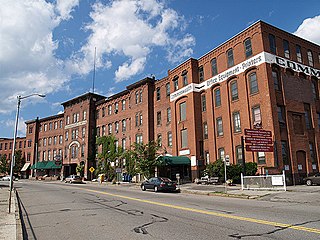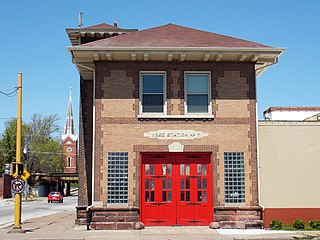
Boathouse Row is an historic site which is located in Philadelphia, Pennsylvania on the east bank of the Schuylkill River just north of the Fairmount Water Works and the Philadelphia Museum of Art. It consists of a row of fifteen boathouses housing social and rowing clubs and their racing shells. Each of the boathouses has its own history, and all have addresses on both Boathouse Row and Kelly Drive.

Tudor Place is a Federal-style mansion in Washington, D.C. that was originally the home of Thomas Peter and his wife, Martha Parke Custis Peter, a granddaughter of Martha Washington. The property, comprising one city block on the crest of Georgetown Heights, had an excellent view of the Potomac River.

The Georgetown–Silver Plume National Historic Landmark District is a federally designated United States National Historic Landmark that comprises the Town of Georgetown, the Town of Silver Plume, and the Georgetown Loop Historic Mining & Railroad Park between the two silver mining towns along Clear Creek in the Front Range of the Rocky Mountains in Clear Creek County, Colorado, United States.

The Alms and Doepke Dry Goods Company is a historic commercial building in Cincinnati, Ohio, United States. Located along Central Parkway on the edge of downtown, it is a late Victorian structure designed by Samuel Hannaford, a renowned Cincinnati architect.

The Dubuque County Jail is a historic building at 36 East 8th Street in Dubuque, Iowa, United States. Completed in 1858, the jail is an example of the uncommon Egyptian Revival style. It is architecturally a highly original work of John F. Rague, who also designed the 1837 Old Capitol of Illinois and the 1840 Territorial Capitol of Iowa. The building was designated a National Historic Landmark for its architecture in 1987. It served as a jail for more than a century, became a museum in 1975, and was converted into county offices in 2016.

The Potter–Collyer House is a historic house at 67 Cedar Street in Pawtucket, Rhode Island. The house, first constructed in 1863, is representative of vernacular architecture of the Pawtucket due to the great modifications to the home which has obscured the original structure of the home. Believed to have begun as a 1+1⁄2-story cottage with a gable roof, subsequent additions and expansions have added a two-story hip-roof addition and greatly altered the floor plan due to enlargement and remodeling. The Potter–Collyer House was added to the National Register of Historic Places in 1983.

The Washburn and Moen North Works District encompass an industrial complex that housed the largest business in Worcester, Massachusetts in the second half of the 19th century.

MacAlpine, Rebecca's Lot is a historic home located at Ellicott City, Howard County, Maryland, United States. It was built by wealthy Baltimore attorney, James Mackubin, for his second wife, Gabriella Peter, a great-great-granddaughter of Martha Washington. She grew up at nearby Linwood, the daughter of Maj. George Washington Parke Custis Peter, who was the second son of Martha Parke Custis Peter of Tudor Place, Georgetown. She attended the famed Patapsco Female Institute and was a leading society member in Maryland. She was a cousin of Robert E. Lee's wife and his children spent many summers here after his death. Gabriella was known to be gracious but demanding. She initially lived at nearby Grey Rock but refused to stay there long as her husband had shared that home with his first wife. Her daughters were unable to leave her side during her lifetime, especially after the accidental 1903 death of her youngest son, Parke Custis, rendering them middle-aged spinsters at the time of her death.

The Canada Hose Company Building is a historic firehouse in Cumberland, Allegany County, Maryland, United States. It is a two-story gable-front brick structure. Above the doors used for the fire engines is a sign which reads "Cumberland Hose Co. No. 1." The building is the oldest of a number of old firehouses built in Cumberland during the 19th century; it was completed in 1845.

The Oak Hill Cemetery Chapel, also known as the Renwick Chapel or James Renwick Chapel, is a historic building in the Georgetown neighborhood of Washington, D.C., United States. Designed by James Renwick, Jr. in 1850, Oak Hill Cemetery Chapel is the architect's only known example of Gothic Revival church architecture in Washington, D.C. It is located on the highest ridge in Oak Hill Cemetery, near the intersection of 29th and R Streets NW. The chapel is one of two structures in Oak Hill Cemetery listed on the National Register of Historic Places, the other being the Van Ness Mausoleum. The chapel, mausoleum, and cemetery are contributing properties to the Georgetown Historic District, a National Historic Landmark.

The West End Hose Company Number 3 is a historic two-story brick firehouse located at 15 North Doughty Avenue in the borough of Somerville in Somerset County, New Jersey, United States. The building was added to the National Register of Historic Places on July 17, 2002 for its significance in architecture and social history. The building is currently the Somerville Fire Department Museum operated by the Somerville Exempt Firemen's Association.

Relief Hose Company No. 2 Engine House is a two-story brick firehouse with a three-story tower located at 16 Anderson Street in the borough of Raritan in Somerset County, New Jersey, United States. The firehouse was built in 1894 and added to the National Register of Historic Places on December 14, 2000 for its significance in architecture. The building is a well-preserved example of a Victorian-era High Gothic style firehouse. The firehouse has hosted many municipal activities and at times housed Borough Council chambers and the public library. The building is still in use as an active firehouse. It currently houses The Raritan Fire Department's 2007 Seagrave Aerialscope Tower Ladder (52-121).

The Hose Station No. 1 is a historic building located in downtown Davenport, Iowa, United States. It was listed on the National Register of Historic Places in 1983 and on the Davenport Register of Historic Properties in 1999. In 2019 it was included as a contributing property in the Davenport Motor Row and Industrial Historic District.

The Central Fire Station is located in downtown Davenport, Iowa, United States and serves as the headquarters of the Davenport Fire Department, as well as the downtown fire station. Built from 1901 to 1902, the original building is the oldest active fire station west of the Mississippi River. It was individually listed on the National Register of Historic Places in 1982. In 2020 it was included as a contributing property in the Davenport Downtown Commercial Historic District.

The Hose Station No. 7 is located along a busy thoroughfare in a light industrial area of the west end of Davenport, Iowa, United States. It was listed on the National Register of Historic Places in 1983.

The Davenport Water Co. Pumping Station No. 2, also known as the Ripley Street Pumping Station No. 2, is a historic building located in central Davenport, Iowa, United States. It was listed on the National Register of Historic Places in 1984. The facility was originally built in 1884 to address problems with the city's water system, and had a reservoir that could hold 5 million US gallons of water. The building was subsequently replaced in 1986 by a smaller plain structure on the same property facing West 14th Street. Despite being replaced, the station remains an important part of Davenport's history, as it was an essential component of the city's water system and contributed to the growth of its residential areas above the bluff line from 1880 to 1920.

Hose Station No. 6 is located in a residential neighborhood in the West End of Davenport, Iowa, United States. It has been listed on the National Register of Historic Places since 1983. It is one of two former fire stations in the West End that are still in existence. The other one is Hose Station No. 7.

Davenport Hose Station No. 3 is located in a commercial area on the east side of Davenport, Iowa, United States. It has been listed on the National Register of Historic Places since 1984. The building is one of two historic former fire stations on the east side that are still in existence. The other one is Hose Station No. 4 in the Village of East Davenport.

Cedar Rapids Central Fire Station, also known as Cedar Rapids Hose Company No. 1 and the Cedar Rapids Science Station, is a historic building located in Cedar Rapids, Iowa, United States. It served as the city's fire department headquarters and downtown fire station from 1918 to 1985. It replaced a frame structure in the northeast quadrant, and was part of a larger program of building new facilities for the local fire department. The building program was a response to a series of disastrous fires, changing technology, and the city's growth. This fire station served from the era of horse-drawn pumper wagons to the modern era of fire engines, pumpers, and hook and ladder trucks. The two-story, brick Mission and Spanish Colonial Revival structure was designed by local architect Charles A. Dieman. In the mid-20th century a two-story kitchen addition was built onto the back of the building.




















